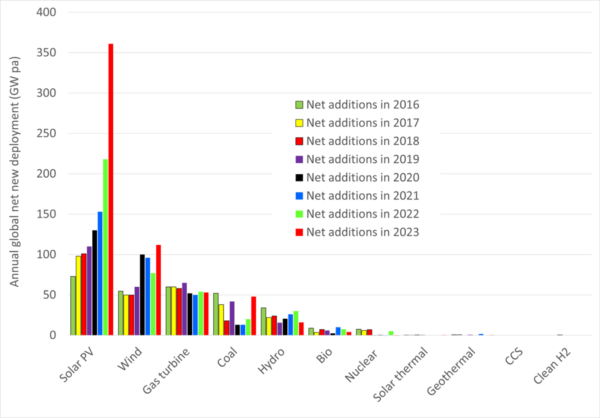Solar photovoltaics and wind contributed about 80% of global net generation capacity additions in 2023; four times as much new solar and wind electricity generation capacity was added as compared to all other sources.

Approximately 80% of net addition to global net generation capacity will come from solar photovoltaics and wind in 2023, marking the fastest energy revolution in history. Compared to everything else combined (gas, coal, hydro, nuclear and others), four times as much new solar and wind electricity was installed in 2023. For new generation capacity, solar and wind are the best options based on market evidence.
 The combined global solar installed capacity and production have surpassed 1.4 TW and 1.7 TW, respectively, which is more than ten times higher compared to a decade ago and doubling every three years. Solar capacity is being installed faster than any other source in history, surpassing nuclear in 2017, wind in 2022, and hydropower last year; it is expected to surpass fossil gas in 2024. At an annual growth rate of 20%, solar is on track to become the largest contributor to global generation capacity by overtaking coal in 2025 and reaching a total of 9 TW by 2031, exceeding all other sources combined.
The combined global solar installed capacity and production have surpassed 1.4 TW and 1.7 TW, respectively, which is more than ten times higher compared to a decade ago and doubling every three years. Solar capacity is being installed faster than any other source in history, surpassing nuclear in 2017, wind in 2022, and hydropower last year; it is expected to surpass fossil gas in 2024. At an annual growth rate of 20%, solar is on track to become the largest contributor to global generation capacity by overtaking coal in 2025 and reaching a total of 9 TW by 2031, exceeding all other sources combined.
 This rapid and sustained expansion of solar and wind generation indicates their potential dominance in meeting the ever-increasing demand for electricity due to rising affluence, population growth, and the trend towards electrification of various functions. As more functions are electrified through the use of electric vehicles, heat pumps, furnaces, and electrolysis of water for hydrogen production used in chemical processes such as metal reduction, ammonia synthesis, fertilizer production, plastics manufacturing as well as synthetic jet and shipping fuels, we can expect solar and wind to eventually displace fossil fuels from most functions.
This rapid and sustained expansion of solar and wind generation indicates their potential dominance in meeting the ever-increasing demand for electricity due to rising affluence, population growth, and the trend towards electrification of various functions. As more functions are electrified through the use of electric vehicles, heat pumps, furnaces, and electrolysis of water for hydrogen production used in chemical processes such as metal reduction, ammonia synthesis, fertilizer production, plastics manufacturing as well as synthetic jet and shipping fuels, we can expect solar and wind to eventually displace fossil fuels from most functions.






